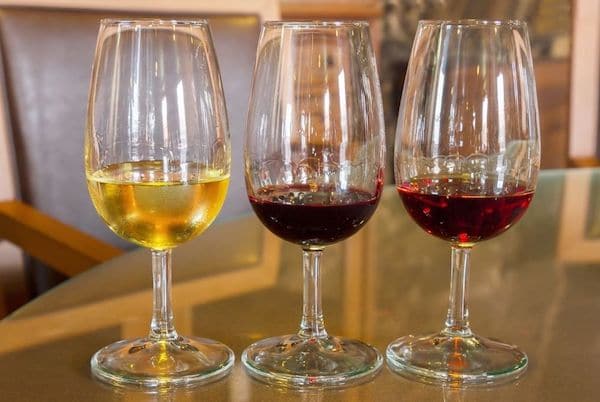Port wine is a traditional fortified wine from the Douro valley in Portugal. This large area is located in the Northern part of the country, just north of Porto.
Only bottles produced in Portugal can be authentic port wine. However, similar to Champagne, this regulation does by no means limit the selection. There are many different styles and also vintage bottles made for long-time aging.
What is Port? | Facts | Different Types | Taste | How it's made | Price | Grapes | How to serve | The right glass | Port in cocktails | Food Pairings | Top brands | FAQs
What is port wine?
Port wine, also Vinho do Porto, is a sweet, fortified wine similar to Vermouth or Sherry. Its alcohol by volume varies slightly depending on variants and brands. But on average, it contains around 20% ABV (40 proof).
It originates from Douro Valley, which can be divided into three regions: the Baixo Corgo, Cima Corgo, and the Douro Superior. Each of these zones has distinct characteristics and different average temperatures.
Grapes growing in the Cima (Engl. higher) Corgo zone are often considered the highest quality grapes. Therefore, they are commonly used for Vintage, Reserve, and aged Tawny ports.
Quick Facts
- Origin: Douro Valley, Portugal
- Taste: Sweet with various flavor profiles (see more)
- Color: Light golden, light red, and dark red
- ABV: approx. 20%
- Proof: 40
- Price: $11 - $200
- Styles: White, Ruby, Tawny, aged Tawny, vintage, and more
The different types
There are seven different main types to differentiate port wines. And most have one or more subcategories, which can get confusing. To keep it short and simple, we only discuss the most important ones here.
Check out our article about the different port wine styles for detailed information on the topic.
- White - White port is made from white grapes. Common types are Malvasia, Rabigato, Vioshinho, Donzelinho, Gouveio, Codega, and many more. Additionally, white ports can be available in a variety of subtypes.
- Ruby - This is the most affordable option. Unlike most other port wines, it usually ages in concrete or stainless steel vessels to avoid oxidation. The result has a bright red color with a fresh and fruity taste.
- Tawny - Tawny ports are made of red grapes and aged in wooden barrels. This aging process allows for oxidation and evaporation, essential for developing its distinct nutty flavors.
- Colheita - A Colheita port is a subcategory of the Tawny. A single vintage Tawny that aged for at least seven years in wooden barrels. You won't find the age on the label but the vintage year instead.
- Garrafeira - Garrafeira is the rarest of all types of ports. The unusual and long aging make this type so precious.
- Vintage Port - pressed from the highest-quality grapes. It's only possible to produce Vintage Port in years declared vintage. That is not super rare, but nowhere near yearly.

Taste
The taste of a port ultimately depends on the respective type and, of course, the brand. I still want to give you a general idea: Overall, port is far sweeter than regular wine. Especially the red types, like Ruby and Tawny, are rich in flavor and among the sweeter ones.
White port is lighter and drier than its red counterparts. That, combined with its citrus and stone fruit notes, works beautifully with tonic water. You can find this refreshing mixed drink, served in grand Copa glasses, all over Porto.
The Rosé port is quite rare and has some unique notes to it. It is a bright mix of strawberry, violets, and caramel.
Red ports are fruitier, heavier, and richer in taste. Common flavors are berries (raspberry, strawberry, and blackberry), caramel, toffee, nuts, cinnamon, vanilla, and chocolate. Ruby tends to be more fruity, while Tawny offers intenser notes of caramel and nuts.
Aged Tawnies have a much larger spectrum of flavors, like green peppercorn, almond, hazelnut, and butterscotch. A general rule of thumb is that the older the port, the more refined its flavors.

How it's made
In the early stages, you make it like any other wine. Later, to enhance richness and increase the ABV, producers add a distilled grape spirit (e.g., Brandy) to the wine base. -Just before all sugar is used up during fermentation.
The Portuguese call this grape spirit aguardente, deriving from the terms água and ardente, which translates to fiery water.
Once grape spirit and wine are blended, fermentation stops, and the port wine is "fortified". By that, the amount of alcohol remains higher, and more residual sugar is left in the wine, making it taste sweeter.
How much does one bottle cost?
The price range for port wine is wide. Standard White, Ruby, and Tawny Port is between $10 - $12. But ports can easily cost way more than that. It isn't unusual to pay $150 - $200 for a rare bottle of aged port wine.
The most expensive bottles sell for thousands of dollars, with Taylor Fladgate Scion Vintage Port being one if not the most expensive one in the world.
The grapes used to make port
The grape varieties for making port wine are heavily regulated. Only 30 types qualify recommendable for making port wine of 82 different types permitted in port wine production. Also, these port grapes are classified as very good, good, average, mediocre, or bad.
To put this into perspective: more than 2.500 grape varieties can be used for making wine. If you need more detailed information, read our guide to grapes used to produce this fortified wine.
How to serve it
The proper temperature is an important part when serving port wine. White port tastes best chilled or in combination with tonic water. Tawny should be served slightly chilled at 10 to 12°C (50°F to 54°F ), Ruby just below room temperature at 16 to 18°C (60°F to 64°F).
The right glass
Only in the right glass can you fully perceive the aromas and flavors of the wine. For this, the right size and shape are vital. Scientists have found that this influences how scents are perceived.
Ideally, a good port should come in a small, specially designed glass reminiscent of Copita or Sherry glasses. The small, narrow opening intensifies the wine's bouquet.
By swirling, you can help the wine to breathe. That helps to develop deeper aromas and flavors, especially with more complex port wines.

Port in cocktails
Port goes very well in cocktails. In fact, it's the crucial element in one of our all-time favorite drinks - the Continental Sour. But there are more intriguing drinks to try with the strong, sweet fortified wine.
One is, for instance, the classic Porto Flip, an excellent after-dinner cocktail, and a white Port & Tonic. This invigorating thirst quencher is a delicious way to incorporate the white variety into a mixed drink.
Food pairings
Port is an ideal wine to pair with sweet or savory snacks. You can match it with mild and creamy cheese and more intense options like blue cheese. Sweet pairings include chocolate, caramel, and nuts. Depending on the type, the food pairing options vary slightly. So here's a quick guide on how to pair ports:
- White: The white expression is a versatile pairing partner. Like regular white wine, it goes well with seafood like smoked salmon, sushi, and shellfish. Further, it pairs well with lightly salty snacks like salted almonds, olives, and gruyere cheese.
- Ruby: the fruity and chocolatey notes in Ruby expressions go very well with dark chocolate, fresh raspberries, and aged cheese.
- Tawny: This port type suits all kinds of nutty foods but also exceptionally well with caramel or chocolate-flavored desserts. Strong, flavorful cheeses like blue cheese, Pecorino, or Roquefort are also fantastic choices.
Top port brands
You can find port in wine shops, liquor stores, and sometimes grocery stores. If you're new to this kind of wine, we recommend sticking with reputable brands first to get an idea of how it should taste.
Here are some brilliant port brands you can buy, sorted alphabetically:
- Cálem
- Ferreira
- Fonseca
- Graham's
- Niepoort
- Quinta Do Noval
- Ramos Pinto
- Sandeman
- Taylor
- Warre
Frequently Asked Questions
An open bottle of port should be stored in the fridge. Like Vermouth and other fortified wines, you best consume it within 2-4 weeks. After that, the wine will lose its aroma and flavor.
Vintage port bottles are designed to age for a very long time. They can easily remain on a shelf for 100 years and more. However, the standard bottles of Tawny or Ruby aren't intended for aging. You should consume them within two years from the purchase date.
You can substitute port by combining dry red wine (2 parts) with Brandy (1 part) and sugar (0.25 parts). That is not a replacement when planning to serve it neat, but suitable for cooking.

